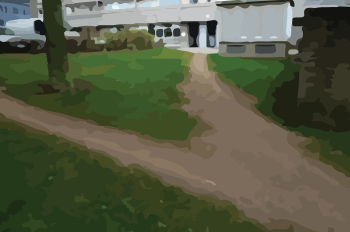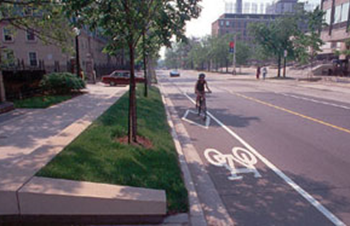InTrans / Oct 14, 2015
Creating active communities: The Complete Streets movement
Go! Magazine
 posted on October 14, 2015
posted on October 14, 2015
This series is dedicated to “movements,” which are identified as people working together to advance a shared political, social, or artistic idea. In this series, we’ll discuss a few social movements that focus on transportation alternatives.
You may be wondering, what is a “Complete Street?” And why is it important? A Complete Street is one accessible to bicycles, pedestrians, as well as automobiles. In other words, it offers accessibility to all users of the road.
Complete Streets make it easy to cross the street, walk to shops, and bicycle to work. But most importantly, it promotes commuter safety.

Think about Houston, which has a commuter population of almost three million (See “Town by town: Suburban living”). And besides that, take into account that the total population is 6.3 million, which includes seniors, children, and the medically disabled who also find themselves on the roadways daily. All of these people are put in danger by traveling on a street that only supports automobiles. Streets that have sidewalks, crosswalks, sloped curbs (See “How do you drive?”), bicycle lanes, and bus infrastructure have the advantage of making the town or city an overall better place to live.
Auto-centric lifestyles
The automobile is a common household asset in 21st century America. In fact, as of 2011, there are 253 million register vehicles in the United States—that’s 1.95 cars per household!
Following World War II, the economy was booming and so was the domestic automobile market. This encouraged a steep rise in automobile ownership due to more affordable cars on the market coupled with higher earning wages. Americans went from owning about 8 million vehicles in the 1920s to almost 61 million in the 1960s. Given this huge increase in automobile ownership, there was a need for more infrastructure. To answer this call, the president at the time, Dwight D. Eisenhower, championed the authorization of the Interstate Highway System in 1956. Known as “the Greatest Public Works Project in History,” this system provides a vital link for connecting goods to markets in the US and around the world and bringing together people from the nation’s cities, towns, and rural communities.
Aging infrastructure
Now nearly 60 years later, the United States faces an age of transition with its aging and outdated infrastructure. The car boom is over. Now is the age of multi-modal transportation, which means that the “users of the road” don’t just mean automobile drivers. Due to climate change, the increased concern for public health, and the fact that one of the biggest percentages of drivers on the road are now millennials (i.e., those born between 1980 and 2000), the interest in living in “walkable” neighborhoods (See “Suburban sprawl series: Young people driving less”) is only growing. In other words, millennials may be shifting the way Americans typically commute, and therefore the policies that surround our transportation priorities.
Times do change, but with the aging infrastructure and shifting transportation priorities there is a noticeable decline in driving trends. Since the 1970s, there was an exponential growth in the number of drivers every year, with few hiccups. Now, following the Great Recession, the millennials are causing a decline.
Despite an anticipated 21 percent increase in population by 2040, vehicle miles traveled is not expected to surpass driving levels from 2007. Additionally, due to high gas prices and the rise of telecommuting (i.e., from home) job positions, more and more people are choosing the “roads less traveled,” and in this case that means bicycle and walking paths.
What does a Complete Street look like (in the city)?
A Complete Street can vary from place-to-place, because it really all depends on the existing infrastructure, road conditions, and project goals. It could be as simple as redeveloping an existing road to allow for a wider sidewalk and the addition of a bike lane.

In Orlando, Florida, the city’s public works division incorporated what is called a “road diet.” This technique, also called a lane reduction or road rechannelization, reduces the number of lanes on a street in an effort to reduce speed and include infrastructure for non-motorized commuters.
The result in Florida? The road was converted from an existing four-lane undivided roadway segment to a three-lane segment consisting of two through lanes and a center two-way left turn lane. The extra space also allowed for the addition of a bike lane as well as some street beautification (See “Why should I care: Storm water”). The road diet increased walking and biking by about 23 and 30 percent, respectively, three years after construction. Additionally, it reduced the crash rate on the street by about 35 percent—something we can all agree is important!
What does a Complete Street look like (in the country)?
In a rural area, however, a Complete Street could look quite different. It may mean installing a wider shoulder on a rural road and reducing the speed limit. It could also mean reducing on-street parking, which would allow the road to be used by more cyclists and pedestrians while still catering to automobile drivers.

Why adopt a Complete Street?
A Complete Street does not require a certain look, but rather the main purpose is to adopt changes to increase the safety of commuters utilizing other forms of transportation.
There is always the added benefit to public health by encouraging active communities. In addition, non-motorized traffic and public transportation can cut down on air emissions and reduce greenhouse gas emissions, which is a great public benefit. Also, alternative transportation can help cut down household costs by reducing expenditures on personal car repairs and gasoline, for example. Ultimately, a community can decide for itself what the priorities are (e.g., more crosswalks, better public transit infrastructure, bike lanes, etc.) and set goals according to those priorities. Improvements can widely vary in cost, depending on the current infrastructure and the new goals. However, if any of the improvements lead to safer roadways for all users, it may be well worth the initial cost.
Related links
https://www.flickr.com/photos/completestreets/sets/72157617261981677/
http://usatoday30.usatoday.com/news/nation/2007-07-29-complete-streets_N.htm
https://smartgrowthamerica.org/search/iowa/
By Jackie Nester, Go! Staff Writer